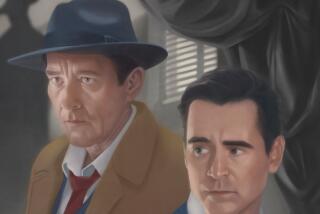Mr. Sandman, Bring Me a Dream : HOT BLOOD: The Money, the Bach Heiress and the Horse Murders.<i> By Ken Englade (St. Martin’s: $23.95, 304 pp.)</i>
- Share via
They called him “the Sandman.” They called him the Sandman because wherever he was, horses would go to sleep. They didn’t wake up.
Tom Burns was his real name, and killing horses, as he confided to friends, was only “a sideline.” Burns was also a thief. Not just any thief, mind you. A thief with a dream. Burns’ dream was to be a used-car salesman. That’s what he does now. It’s the American way. Burns’ sideline, though, proved to be a link, a nexus by which prosecutor Steven Miller was able to connect not only an insurance fraud perpetrated by socially prominent members of the equestrian aristocracy but also the cynical swindle of a score of wealthy widows and the disappearance and presumed murder of candy heiress Helen Brach, who vanished without a whisper in 1977.
For the record:
12:00 a.m. Sept. 29, 1996 For the Record
Los Angeles Times Sunday September 29, 1996 Home Edition Book Review Page 2 Book Review Desk 1 inches; 34 words Type of Material: Correction
“Hot Blood”--The photo illustration that accompanied the review of Ken Englade’s “Hot Blood” in the Sept. 1 Book Review was not from the book. Neither the illustration nor the rider in the photo has any association with the book whatsoever.
Sorting out the disparate elements of parallel narratives whose only commonality is surpassing greed is the job of a pro. Ken Englade, investigative reporter and true-crime author, is a pro. No similes, no metaphors, no frangipani. Just a story, told well and true.
Miller’s job was harder. The Chicago district attorney and his team spent five years tracing each strand of the tangled web to the center where the spider was. Englade, for his part, lingers too long on investigation and especially on courtroom, where prose, however sturdy, tends to plod. No matter. Fundamental drama carries the chronicle.
A ready-made lineup of louses doesn’t hurt. (OK, lice. Whatever.) Englade has only to scratch to turn them out in abundance and generally has the good sense to let them speak for themselves.
“The Sandman,” in fact, is the most sympathetic of the lot, a felon of a certain grungy nobility. For one thing, he favors execution by electricity. Not only is the method virtually indistinguishable from death by colic, but Burns also is convinced that it’s humane. (He does, however, collaborate with a business colleague in equinicide by crowbar.) At the least, the Sandman is sorry. (“I was just a piece of garbage.”)
Less distinguished, entirely without scruple, is quasi-dapper Richard Bailey. Short but trim, well-tailored if faintly flashy, glib of tongue, Bailey, 60ish, is the pinkie-ring kind of guy who drives a Mercedes convertible and knows his sommeliers if not his Sauvignon. The con man’s career choice is a muddy study of ignobility. He has moved from ballroom dancing instructor to driving school entrepreneur--his shiftless students graduate only when broke--to purveyor of hot horses only slightly less spavined than those who invest in them. (A “hot horse” refers to Arabs or thoroughbreds--the tense, high-strung horses raised for racing or, as in this book, for show.)
Along the way, Bailey has learned the indispensable lesson of the con: flattery. He meets his victims at Chicago-area riding stables owned by unsavory colleagues, sends them roses, squires them to posh restaurants, hints at marriage, takes them to bed. (“I close my eyes and think of the money.”) And then the sting: I’ve got to close this incredible deal on a broodmare by tomorrow, but I’m a little short of cash. All lose fortunes. One loses her house. One is reduced to shoplifting, another to eating dog food.
Helen Brach is made of sterner stuff (but not much: Even after being bilked of hundreds of thousands, she flies Bailey to New York so they can dance to Guy Lombardo). Somewhat less smitten, Brach becomes suspicious. There is vague talk with an acquaintance about legal action. Soon afterward, she disappears. Her body has never surfaced.
Acknowledging that there must be a charm about Bailey that is not immediately evident, Englade reserves the brunt of his disdain for the horsy set that spends millions on show steeds for appearance’s sake, then discards aging, recalcitrant or infirm horses the way Bailey disposes of widows. George Lindemann Jr., in particular, comes up smelling like manure.
Lindemann, heir to $800 million, is a rider of show jumpers who aspired to the U.S. Olympic team going to Atlanta. In the course of “Hot Blood,” he is tried for and convicted of hiring the Sandman to kill Charisma, his spirited, playful show horse whose only sin was inconsistency, so that he could collect $250,000 in insurance money. This is one way to sidestep the scorn attendant on poor performance. “A horse doesn’t know when it wins but the owner does,” says prosecutor Miller, “and everyone else in this small, elite circle knows when it wins, too, and they talk, and they snicker. . . .”
People are defrauded, ruined, even murdered in “Hot Blood,” but it is the destruction of horses by their pedigreed “protectors” that lingers and disturbs. The practice, Englade reports, is widespread. It is “the horse world’s dirty little secret.”


